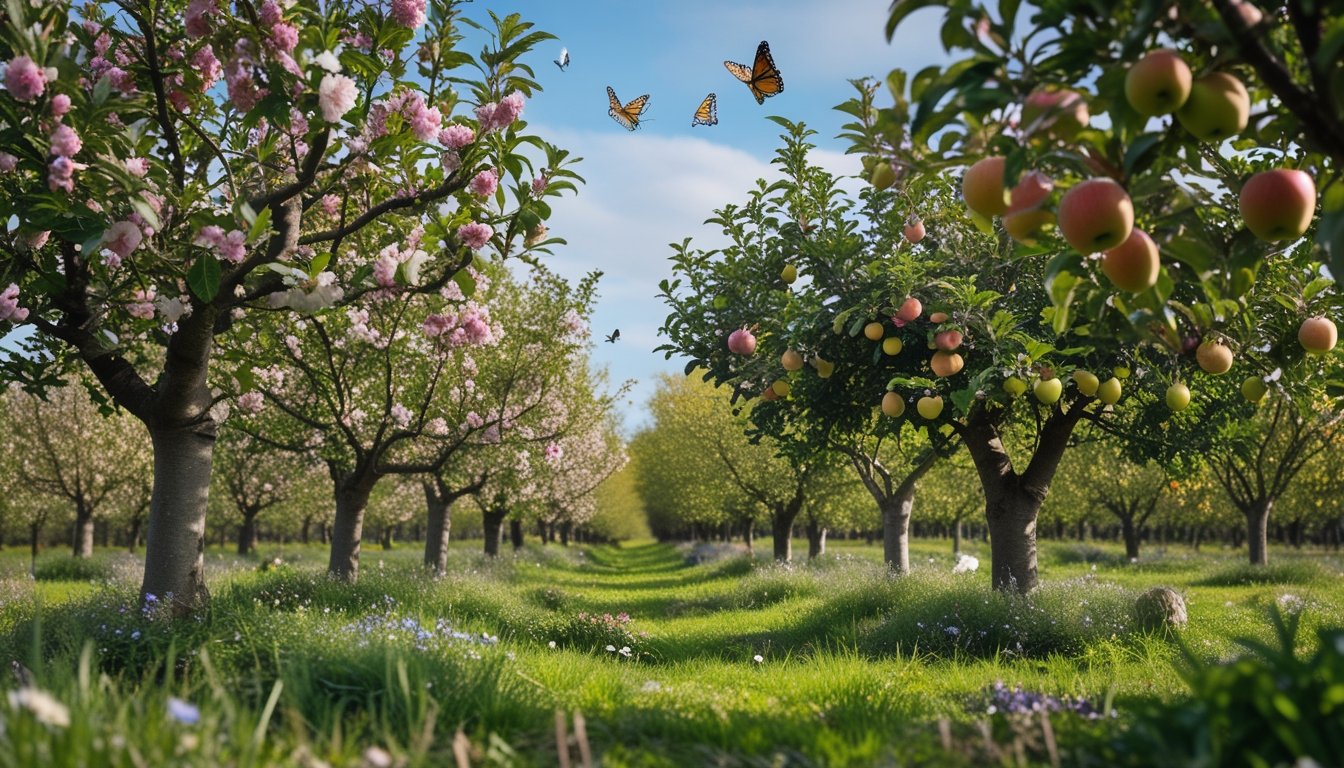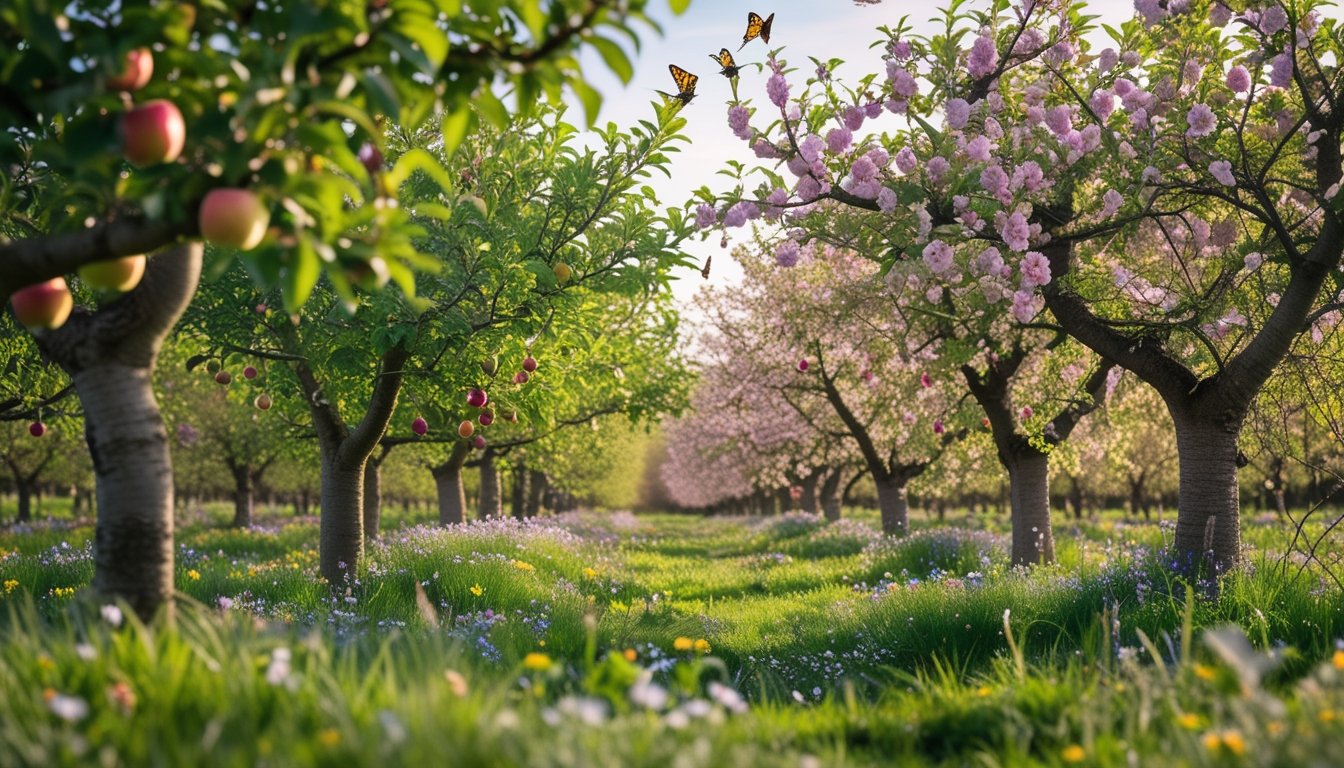Late updated: 24 Aug 2025 13:08
Written by: Emily Thornton
The Importance Of Native UK Orchards For Biodiversity: Enhancing Ecosystems
Native UK orchards are not just picturesque landscapes; they are vital components of the biodiversity tapestry. These orchards provide critical habitats for countless species of wildlife, contributing significantly to ecological balance and sustainability. Despite their artificial origin, traditional orchards often contain a diversity of plant and animal life that rivals, and sometimes exceeds, that of natural woodlands.

As we consider their ecological role, it’s clear that these orchards serve as refuges for various species. They support a mosaic of habitats that include grasslands, fruit trees, and deadwood, all essential for over 1,800 species of plant, animal, and fungus. Their continued preservation is crucial, given their historical value and the modern threats they face from agricultural intensification and land development.
We must look beyond their aesthetic appeal to understand their significance as biodiversity hotspots. This perspective not only enhances our appreciation but also fuels efforts to protect and rejuvenate these invaluable ecosystems. By highlighting why they are indispensable to our environment, we invite a deeper engagement with and commitment to preserving them for future generations.
Key Takeaways
- Native orchards are essential for UK biodiversity.
- They provide crucial habitats for diverse wildlife.
- Preservation is vital for maintaining ecological balance.
Ecological Role Of Native UK Orchards
Native UK orchards hold immense ecological significance. They serve as critical habitats supporting diverse species and contribute to maintaining the biodiversity of the landscape. These orchards, often home to a mix of fruit and nut trees, embody a unique structural complexity pivotal for wildlife.
Biodiversity Hotspots And Priority Habitats
Native UK orchards are biodiversity hotspots recognised as priority habitats. These environments support a wide array of species, offering crucial habitats for insects like bees and butterflies, as well as birds and small mammals. This rich biodiversity is a testament to the minimal agricultural disturbances typically found in these settings. The UK Government's Biodiversity Action Plan acknowledges traditional orchards for harbouring conservation priority species. Within these habitats, species find essential refuges, with traditional management practices helping sustain their delicate ecosystems.
Traditional Orchard Structure And Features
Traditional orchards feature a low-density planting style with thriving fruit and nut trees. This layout creates habitats resembling older woodlands, even though they are often of artificial origin. The trees in these orchards develop crevices and hollows, becoming ideal nesting sites for bird species like the spotted flycatcher. Lichen, moss, and diverse fungi flourish on the bark, contributing to the orchard's unique microhabitats. Grassland undergrowth provides habitat for invertebrates, further enhancing their ecological value. This intricate structure fosters resilience, supporting more species compared to intensively managed agricultural zones.
Key Fruit And Nut Species In UK Orchards
The variety of fruit and nut species in these orchards further amplifies their ecological role. Apple, pear, plum, and cherry trees, alongside nuts like cobnut, walnut, and hazel, contribute to a heterogeneous habitat. These species provide food sources and nesting sites, supporting a wide range of fauna. Notably, species like the damson and specific apple varieties, often unique to these orchards, add genetic diversity to the landscape. This genetic pool plays a crucial role in ecosystem health, making orchards indispensable for conserving biodiversity. Our stewardship of these orchards helps maintain the balance required for thriving ecosystems.
Native Orchards As Vital Habitats For Wildlife

Native orchards provide diverse habitats essential for various species, including those that are rare or specialised. These environments offer nesting and foraging sites, use deadwood for unique ecological niches, and benefit from connectivity provided by hedgerows. Let's explore these critical aspects in greater detail.
Specialist Species And Rare Invertebrates
Native orchards are unique ecosystems supporting specialist species like the noble chafer beetle. These insects rely on old fruit trees for their habitat, feeding on decaying wood.
Rare invertebrates find these environments ideal due to the microhabitats created by the varied plant species. With their abundance of fungi, lichens, and mosses, orchards are indispensable for maintaining these specialised communities.
These unique conditions make orchards a refuge for invertebrate diversity. Not only do these species contribute to the local food chain, but they also enhance the soil quality through their decomposition activities, promoting a healthier orchard ecosystem.
Supporting Birds, Mammals, And Pollinators
Orchards are particularly appealing to various wildlife, offering nesting and feeding opportunities. Birds, like the lesser spotted woodpecker, thrive in these environments, making use of the cavity-rich veteran trees for roosting.
Mammals such as bats also benefit, finding refuge in the tree hollows. Our orchards further support diverse pollinator populations, including bees, which are vital for fruit production and ecosystem health.
In community orchards, where biodiversity is prioritised, the interplay of these species creates a balanced and thriving habitat. Birds aid in pest control, while pollinators ensure the continued growth and reproduction of fruit trees.
Importance Of Deadwood And Veteran Trees
Deadwood within orchards holds immense ecological value, offering a habitat for many fungi and micro-organisms. These fallen branches and decaying trees support various wildlife forms essential for nutrient cycling.
Veteran trees, often centuries old, serve as critical habitat structures. They provide nesting sites for birds and bats, and the decaying wood offers a substrate for specialist fungi.
The presence of these veteran trees fosters biodiversity; they act as monumental ecological pillars within the orchard. In maintaining these trees, we support the intricate web of life, playing a role in the orchard’s health and resilience.
Role Of Hedgerows And Habitat Connectivity
Hedgerows surrounding orchards contribute significantly to habitat connectivity, acting as corridors for wildlife. These linear woodlands enable species movement, enhancing genetic diversity and resilience of populations.
Hedgerows provide nesting sites for birds and mammals and serve as foraging grounds for pollinators. Their dense thickets offer protection against predators and extreme weather conditions.
Incorporating hedgerows with orchards maximises biodiversity benefits. By connecting habitats, we create a more robust ecosystem capable of withstanding environmental changes and supporting a wider range of species.
Frequently Asked Questions

Exploring the significance of native UK orchards reveals their critical role in fostering biodiversity. These orchards not only offer refuge to numerous species but also contribute to ecological stability and sustainability.
What are the benefits of preserving traditional orchards for local wildlife?
Traditional orchards provide essential habitats for various wildlife species. They support a diverse set of organisms, ranging from mammals to invertebrates, by offering food resources and shelter. This diversity is vital for maintaining healthy ecosystems.
How do native orchards contribute to maintaining ecological balance?
Native orchards play a pivotal role in ecological balance. By preserving a variety of plant and animal species, they help regulate ecosystem dynamics. The interdependence of species ensures resilience against environmental changes, thus sustaining overall ecological health.
In what ways do UK orchards support pollinator populations?
UK orchards are crucial for pollinators like bees and butterflies. They supply a continuous source of nectar and pollen throughout the growing season. This abundance helps maintain robust pollinator populations, which in turn enhances crop yields and plant diversity.
What role do indigenous orchard trees play in sustaining bird biodiversity?
Indigenous orchard trees are vital for bird biodiversity. They offer nesting sites, feeding opportunities, and protection. Species like woodpeckers and warblers find favourable conditions within these trees, contributing to healthy avian communities in the UK.
How can the management of orchards enhance habitat variety for different species?
Effective orchard management can diversify habitats by incorporating practices such as sward length variation and deadwood retention. These efforts create a mosaic of microhabitats catering to multiple species' needs, thus enriching biodiversity within the orchards.
What measures are necessary to protect the biodiversity of UK's native orchards?
To protect orchard biodiversity, we must implement sustainable practices like controlled pruning, pest management without harmful chemicals, and promoting native plant growth. Ensuring connectivity between orchards and other natural habitats is also crucial to support species movement and genetic diversity.
